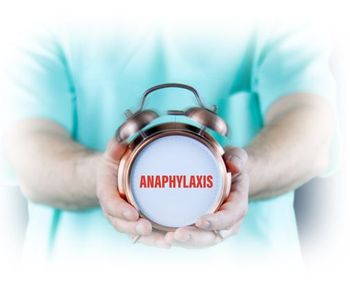
Allergy Aptitude Test: Round 1
What allergy-aggravating pollen belongs to genus Ambrosia? What do bananas have in common with ragweed? Is rhinophototherapy the next new treatment for allergic rhinitis? Find answers to these and test your allergy aptitude with a total of 7 questions in round 1 of our quiz.
Question 1:
Answer on next page »
Answer: C. Environmental phthalate levels
Global increases in temperature and shifting weather patterns may result in earlier flowering and an earlier start to-and extension of-the pollen and allergy season. Higher levels of carbon dioxide caused by urbanization also contribute to warmer temperatures and may support earlier pollination. Phthalates, however, are found in plastic products like toys, food containers, and paints. Phthalates can leach out of these materials into food, dust, and other materials. When humans ingest, inhale, or absorb phthalates through the skin, these compounds may act as indoor allergens, or increase the potency of other allergens.1
Next question »
Question 2:
Answer on next page »
Answer: D. A (Ambrosia artemisiifolia) and B (Ambrosia trifida)
Ragweed belongs to the aster family, and is native to North America. The most widespread species worldwide are common, or short ragweed (Ambrosia artemisiifolia), and great ragweed (Ambrosia trifida), both of which are the most clinically relevant in causing allergic rhinitis. There are approximately 50 species of ragweed, distribution of which varies by geography. A. maritime is found around the Mediterranean and causes the most severe symptoms in this region. Paradoxically, the genus name for ragweed, Ambrosia, derives from the Greek “food of the Gods,” a name with which many seasonal allergy sufferers might disagree.2
Next question »
Question 3:
Answer on next page »
Answer: D. A (banana) and C (melon)
Initial sensitization to ragweed can result in IgE cross-reaction to allergens and hypersensitivity to certain raw fruits, causing pollen-food syndrome. Common symptoms include throat and ear irritation, as well as swollen lips, though anaphylaxis can sometimes occur.3 Because these allergens degrade with heat, cooking the offending food before ingestion can alleviate the problem. Typically, pollen-food syndrome occurs in people who have allergies to birch, grass, and ragweed. Birch pollen is associated with cross reactions to apple, almond, carrot, celery, cherry, hazelnut, kiwi, peach, pear, and plum. Grass pollen is associated with reactions to celery, melons, oranges, peaches, and tomato. Ragweed pollen is associated with reactions to banana, cucumber, melons, sunflower seeds, and zucchini.4
Next question »
Question 4:
Answer on next page »
Answer: D. All of the above
According to a recent review, “sound evidence” exists for monotherapy with oral antihistamines and topical glucocorticoids like fluticasone furoate in the symptomatic treatment of seasonal rhinoconjunctivitis. Leukotriene receptor antagonists like montelukast were also found to be effective when used in combination with antihistamines, though further evidence is needed to support their efficacy as monotherapy. Use of newer agents like the third generation antihistamine desloratadine may result in less drowsiness and cognitive dysfunction than first generation antihistamines like diphenhydramine.3
Next question »
Question 5:
Answer on next page »
Answer: D. All of the above
Children with allergic rhinitis sometimes rub their noses upwards, a gesture often called the “allergic salute,” which can cause a crease across the nasal bridge. Sometimes these children have an extra skin fold or lines under the lower eyelids, which are known as Denny-Morgan lines and are caused by edema and used as a diagnostic marker for allergy. Allergic “shiners” result from fluid accumulation in the infraorbital groove, causing dark shadows beneath the lower eyelid. Patients may also engage in frequent throat clearing or have a hoarse voice. Intranasal exam should be performed to rule out nasal polyps.5
Next question »
Question 6:
Answer on next page »
Answer: B. False. People who live in northerly latitudes have higher risk of developing hay fever.
Allergic rhinitis may affect more than three-quarters of children who suffer from asthma.6 Minimal persistent inflammation is characterized by inflammatory infiltrates in the nasal mucosa that do not cause overt allergy symptoms, but can lead to a subclinical state that may predispose to more frequent viral colds.7 Allergic rhinitis can present as rhinorrhea, sneezing, itching, and nasal blockage. Blockage as the predominant symptom may be less recognizable, resulting in missed diagnosis.5 People who live closer to the equator may be at increased risk for hay fever and asthma. Though the mechanism is unclear, it may have to do with modulation of Th2 cytokine responses in relation to vitamin D levels and UVB exposure.1,8
Next question »
Question 7:
Answer on next page »
Answer: D. All of the above
Several open clinical trials suggest that intranasal phototherapy using UVA or combined UBV/UVA/visible light may be a potential therapy for SAR.2 Nasal filters prevent inhalation of allergens using a simple physical barrier to block particles of varying sizes from entering nasal passages.2 In 2015, the American Academy of Otolaryngology-Head and Neck Surgery recommended acupuncture as a possible treatment for patients desiring nonpharmacologic treatment for SAR.9 A recent randomized controlled trial looked at the efficacy of 12 sessions of acupuncture over 4 weeks in 175 participants randomized to acupuncture vs sham acupuncture. Acupuncture significantly decreased sneezing, itchiness of the ears and palate, and improved quality of life, compared to sham acupuncture. Acupuncture may have anti-inflammatory effects, which may explain the improvement.10
References:
1. Jalbert I, Golebiowski B. Environmental aeroallergens and allergic rhino-conjunctivitis.
2. Ihler F, Canis M. Ragweed-induced allergic rhinoconjunctivitis: current and emerging treatment options.
3. Egger M, Mutschlechner S, Wopfner N, et al. Pollen-food syndromes associated with weed pollinosis: an update from the molecular point of view.
4. American College of Allergy, Asthma, & Immunology. Oral allergy syndrome.
5. Scadding GK. Optimal management of allergic rhinitis.
6. Ponte EV, Franco R, Nascimento HF, et al. Lack of control of severe asthma is associated with co-existence of moderate-to-severe rhinitis.
7. Cirillo I1, Marseglia G, Klersy C, et al. Allergic patients have more numerous and prolonged respiratory infections than nonallergic subjects.
8. Oktaria V, Dharmage SC, Burgess JA, et al. Association between latitude and allergic diseases: a longitudinal study from childhood to middle-age.
9. Xue CC, Zhang AL, Zhang CS, DaCosta C, Story DF, Thien FC. Acupuncture for seasonal allergic rhinitis: a randomized controlled trial.
10. Seidman MD1, Gurgel RK, Lin SY, Schwartz SR, et al. Guideline Otolaryngology Development Group. AAO-HNSF. Clinical practice guideline: Allergic rhinitis.
Newsletter
Enhance your clinical practice with the Patient Care newsletter, offering the latest evidence-based guidelines, diagnostic insights, and treatment strategies for primary care physicians.



























































































































































































































































































































